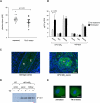Enhancing tumor-specific uptake of the anticancer drug cisplatin with a copper chelator
- PMID: 20541702
- PMCID: PMC2902369
- DOI: 10.1016/j.ccr.2010.04.011
Enhancing tumor-specific uptake of the anticancer drug cisplatin with a copper chelator
Abstract
Uptake of the anticancer drug cisplatin is mediated by the copper transporter CTR1 in cultured cells. Here we show in human ovarian tumors that low levels of Ctr1 mRNA are associated with poor clinical response to platinum-based therapy. Using a mouse model of human cervical cancer, we demonstrate that combined treatment with a copper chelator and cisplatin increases cisplatin-DNA adduct levels in cancerous but not in normal tissues, impairs angiogenesis, and improves therapeutic efficacy. The copper chelator also enhances the killing of cultured human cervical and ovarian cancer cells with cisplatin. Our results identify the copper transporter as a therapeutic target, which can be manipulated with copper chelating drugs to selectively enhance the benefits of platinum-containing chemotherapeutic agents.
Copyright 2010 Elsevier Inc. All rights reserved.
Figures





Similar articles
-
Increase in expression of the copper transporter ATP7A during platinum drug-based treatment is associated with poor survival in ovarian cancer patients.Clin Cancer Res. 2003 Dec 1;9(16 Pt 1):5853-9. Clin Cancer Res. 2003. PMID: 14676106
-
EGCG Enhances Cisplatin Sensitivity by Regulating Expression of the Copper and Cisplatin Influx Transporter CTR1 in Ovary Cancer.PLoS One. 2015 Apr 30;10(4):e0125402. doi: 10.1371/journal.pone.0125402. eCollection 2015. PLoS One. 2015. PMID: 25927922 Free PMC article.
-
Increased expression of the copper efflux transporter ATP7A mediates resistance to cisplatin, carboplatin, and oxaliplatin in ovarian cancer cells.Clin Cancer Res. 2004 Jul 15;10(14):4661-9. doi: 10.1158/1078-0432.CCR-04-0137. Clin Cancer Res. 2004. PMID: 15269138
-
Mechanism of tumor resistance to cisplatin mediated by the copper transporter ATP7B.Biochem Cell Biol. 2011 Apr;89(2):138-47. doi: 10.1139/o10-150. Biochem Cell Biol. 2011. PMID: 21455266 Review.
-
Overcoming platinum drug resistance with copper-lowering agents.Anticancer Res. 2013 Oct;33(10):4157-61. Anticancer Res. 2013. PMID: 24122978 Free PMC article. Review.
Cited by
-
Molecular mechanisms of cisplatin resistance in cervical cancer.Drug Des Devel Ther. 2016 Jun 7;10:1885-95. doi: 10.2147/DDDT.S106412. eCollection 2016. Drug Des Devel Ther. 2016. PMID: 27354763 Free PMC article. Review.
-
Overexpression of the RNA-binding proteins Lin28B and IGF2BP3 (IMP3) is associated with chemoresistance and poor disease outcome in ovarian cancer.Br J Cancer. 2015 Jul 28;113(3):414-24. doi: 10.1038/bjc.2015.254. Epub 2015 Jul 9. Br J Cancer. 2015. PMID: 26158423 Free PMC article.
-
Hyperthermic potentiation of cisplatin by magnetic nanoparticle heaters is correlated with an increase in cell membrane fluidity.Int J Nanomedicine. 2013;8:1003-13. doi: 10.2147/IJN.S38842. Epub 2013 Mar 6. Int J Nanomedicine. 2013. PMID: 23493492 Free PMC article.
-
The Crucial Findings Derived from the Special Issue "Inside Cancer Genomics: From Structure to Therapy".Cancers (Basel). 2023 Jul 4;15(13):3488. doi: 10.3390/cancers15133488. Cancers (Basel). 2023. PMID: 37444598 Free PMC article.
-
"Pincer movement": Reversing cisplatin resistance based on simultaneous glutathione depletion and glutathione S-transferases inhibition by redox-responsive degradable organosilica hybrid nanoparticles.Acta Pharm Sin B. 2022 Apr;12(4):2074-2088. doi: 10.1016/j.apsb.2021.10.013. Epub 2021 Oct 21. Acta Pharm Sin B. 2022. PMID: 35847508 Free PMC article.
References
-
- Atallah E, Flaherty L. Treatment of metastatic malignant melanoma. Curr. Treat. Options Oncol. 2005;6:185–93. - PubMed
-
- Brewer GJ, Merajver SD. Cancer therapy with tetrathiomolybdate: antiangiogenesis by lowering body copper – a review. Integr. Cancer Ther. 2002;1:327–337. - PubMed
-
- Brewer GJ. The use of copper-lowering therapy with tetrathiomolybdate in medicine. Expert Opin. Investig. Drugs. 2009;18:89–97. - PubMed
-
- Bull PC, Thomas GR, Rommens JM, Forbes JR, Cox DW. The Wilson disease gene is a putative copper transporting P-type ATPase similar to the Menkes gene. Nat. Genet. 1993;5:327–337. - PubMed
Publication types
MeSH terms
Substances
Grants and funding
LinkOut - more resources
Full Text Sources
Other Literature Sources
Molecular Biology Databases
Research Materials

